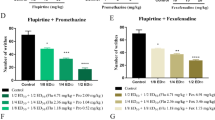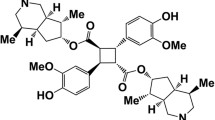Abstract
The effects of vitamin B12 are compared to those of aspirin and 0.9% saline in three different experimental pain models in rats and mice; an electric shock test, the hotplate test, and the phenylbenzoquinone writhing test. Neither cyanocobalamin nor hydroxocobalamin showed any antinociceptive activity in any of the three tests at any of the doses used, whether the drug was administered as a single injection or as a series of daily injections lasting 7 days. These results run counter to those of clinical trials in man, though close scrutiny of the experimental procedures used in these trials often reveals a lack of rigor which casts doubts on their validity. This consideration, together with the negative findings reported here, suggests that the clinical use of vitamin B12 as an analgesic may be inappropriate.
Similar content being viewed by others
References
Charpentier J (1961) Sur une nouvelle méthode psychophysiologique de mesure quantitative des réactions douloureuses chez le rat. C R Soc Biol 155:727–731
Charpentier J (1964) Recherche sur le mécanisme d'action de certains analgésiques centraux (morphine, péthidine, dextromoramide). Psychopharmacologia 5:182–197
Charpentier J (1966) Nouvelle recherche sur le mécanisme d'action de quelques analgésiques centraux (acide acétylsalicylique, imipramine, iminostilbène). Psychopharmacologia 10:126–147
Dangoumau J, Pehourcq F (1980) Intérêt des données pharmacologiques pour prévoir l'efficacité et la toxicité d'un analgésique. In: INSERM and DPhM (Eds) Bases scientifiques et règlementaires de l'Evaluation des Médicaments, Colloque INSERM, vol 96, pp 295–304
Dennert VR, Munzenberg KJ, Haase W (1976) Zur Therapie der Zewiko-Brachialgie, kontrollierter klinischer Vergleich einer hochdosierten Kombination neurotroper Vitamine mit einem Analgetikum. Fortschr Med 94:595–598
Eddy NB, Leimbach D (1953) Synthetic analgesies. II. Diethienylbutenylamines and diethienylbutylamines. J Pharmacol Exp Ther 107:385–393
Eschalier A, Montastruc JL, Devoize JL, Rigal F, Gaillard Plaza G, Pechadre JC (1981) Influence of naloxone and methysergide on the analgesic effect of clomipramine in rats. Eur J Pharmacol 74:1–7
Food and Drugs Administration US (1979) Department of Health, Education and Welfare. Guidelines for the clinical evaluation of analgesic drugs. pp 1–13
Hendershot LC, Forsaith J (1959) Antagonism of the frequency of phenylquinone-induced writhing in the mouse by weak analgesics and non analgesics. J Pharmacol Exp Ther 125:237–240
James J, Warin RP (1971) Sensitivity to cyanocobalamin and hydroxocobalamin. Br Med J 2:262
Lavieg G (1968) Action antalgique dans les affections rhumatismales du Novobédouze dix mille utilisé par voie veineuse. La Vie Médicale 49:1285–1291
Leitch GB (1953) Vitamin B12 in massive dosages for herpetic lesions. Northwest Med 52:291–292
Linee P (1972) Test des crampes abdominales provoquées chez la souris par la phénylbenzoquinone. J Pharmacol (Paris) 3:513–515
Mantz JM, Paul G, Meyer P, Tempe JD, Jaeger A, Kopferschmidtt J, Sauder Ph, Muller JJ, Flesch F, Bennatti A (1982) Le choc anaphylactique. Résultats d'une enquête nationale portant sur 1047 cas. Rev Med Intern 3:331–338
Mellendy O (1953) Vitamin B12 in arthrosis. JAMA 152:957
Mery C (1980) Essai thérapeutique des antalgiques. Diamant (ed) Paris, pp 21–54
Milhaud G (1962) Supériorité biologique de l'hydroxocobalamine. Etude effectuée à l'aide d'hydroxocobalamine marquée. Sem Hôp Paris 38:859–860
Natali R (1969) Action de l'hydroxocobalamine à doses massives dans les cancers de la sphère ORL. Ann Oto Laryngol (Paris) 86:501–506
Siegmund E, Cadmus R, Lu G (1957) A method for evaluating both non-narcotic and narcotic analgesics. Proc Soc Exp Biol Med 95:729–731
Spriet A, Simon P (1980) Methodologie des essais cliniques des médicaments. Prospective Medicale (ed) pp 35–86
Surtees SJ, Hughes RR (1954) Treatment of trigeminal neuralgia by vitamin B12. Lancet 1:439–441
Vacher J, Duchene-Marullaz P, Barbot P (1964) A propos de quelques produits usuels. Comparaison de deux méthodes d'étude des analgésiques. Medicine Experimentalis 11:51–58
Wallenstein S, Zucker CL, Fleiss JL (1980) Some statistical methods useful in circulation research. Circ Res 47:1–9
Woolf G, MacDonald AD (1944) Evaluation of the analgesic action of pethidine hydrochloride. J Pharmacol Exp Ther 80:300–307
Author information
Authors and Affiliations
Rights and permissions
About this article
Cite this article
Eschalier, A., Aumaître, O., Decamps, A. et al. A comparison of the effects of vitamin B12 and aspirin in three experimental pain models in rats and mice. Psychopharmacology 81, 228–231 (1983). https://doi.org/10.1007/BF00427267
Received:
Issue Date:
DOI: https://doi.org/10.1007/BF00427267




